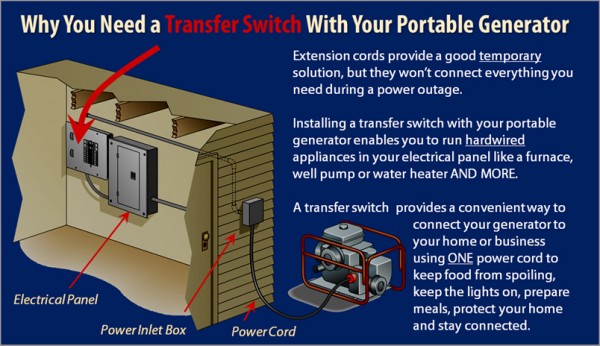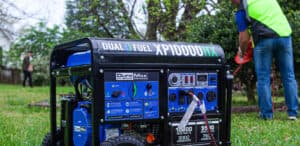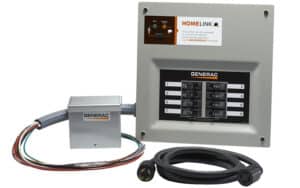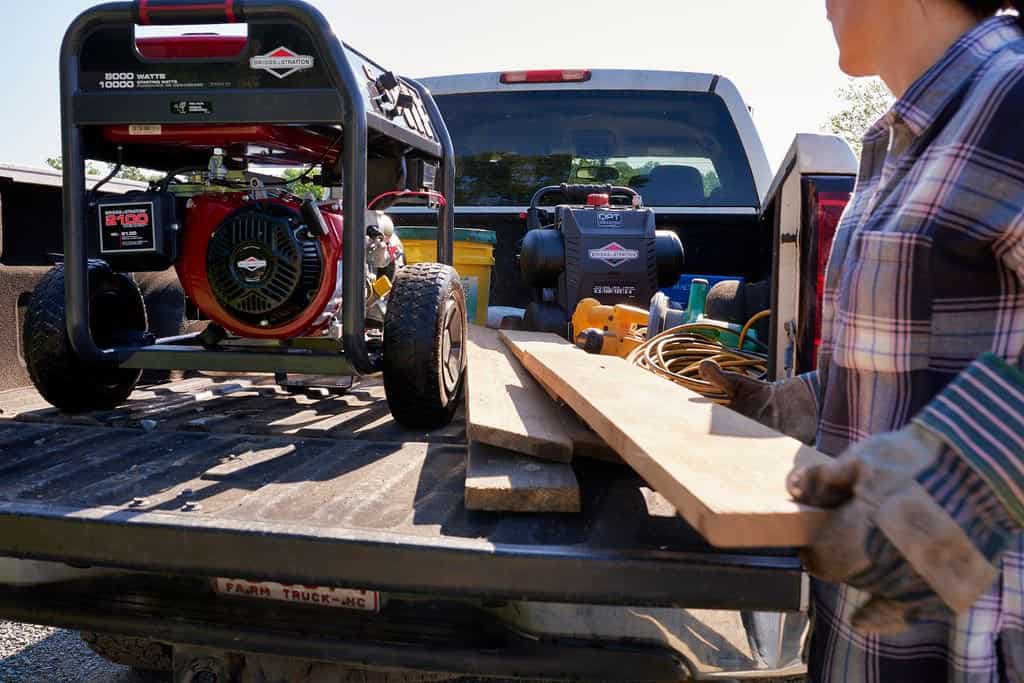A Transfer Switch for Portable Generator Use in a Power Outage
Portable generators that supply essentials with power are a cost-effective option to keep the power on to refrigerators, well pumps and furnaces. Planning and preparing for a power outage requires more than just buying a generator. There are several key points to consider and one of those is how to bring power from the generator into the home.
A manual transfer switch for the generator is the easiest, safest and most convenient way to supply your home with electrical power during a power outage, but it requires installation in advance of the outage. A manual transfer switch is the best solution for connecting a portable generator for home backup.
How to Prepare for a Power Outage
Generator Manual Transfer Switch Connections

A transfer switch, now required by the National Electric Code, connects to the circuits in your electrical panel that you’ll need most during a power outage, like a furnace, lights, well pump, television, garage door opener, etc.
Portable generators move anywhere and are not permanently connected. Most people keep them in their garages or sheds.
A generator cord carries electrical current from the generator to an inlet box. The plug end connects to the generator receptacle and the receptacle end plugs into the inlet box. The generator power cord has four wires for ground, neutral and two wires that each carry 120 volts, for a total of 240 volts.
The inlet box is mounted to the home in a convenient location. The generator is placed where exhaust fumes from the generator will not enter the home through air vents or windows. The manual transfer switch connects permanently to the plug inside the inlet box. Generator placement is important for safety.
How to Use a Portable Generator for Backup Power
Transfer Switch Main Breakers
 The manual transfer switch has two main circuit breakers similar to the main breakers in your service panel. One of the main breakers connects to the wires that come from the inlet box and control the power from the generator. The other main breaker connects to wires from your service panel and supply the switch with power from the electric utility. These wires connect to a branch circuit breaker in the service panel.
The manual transfer switch has two main circuit breakers similar to the main breakers in your service panel. One of the main breakers connects to the wires that come from the inlet box and control the power from the generator. The other main breaker connects to wires from your service panel and supply the switch with power from the electric utility. These wires connect to a branch circuit breaker in the service panel.
The two main breakers in the transfer switch are connected by a mechanical device that only allows one main breaker to be in the “ON” position at any time. Some transfer switches allow positioning both main breakers in the “OFF” position.
4 Part Series: Planning a Manual Transfer Switch Installation
Essential Branch Circuits
The circuits that receive power from the generator connect to circuit breakers in the manual transfer switch. The installer removes the wire from the circuit breaker in the main panel and connects it to the circuit breaker inside the transfer switch.
Best Portable Generator for Home Use
Circuit breakers protect wires from overloading whether the power is supplied from the generator or from the electric utility. Connect wires from a 15-Amp breaker in the main panel to a 15-Amp breaker in the transfer switch. Use the same size breaker in the transfer switch as the main panel for each circuit. Using a breaker rated for more current could allow the wires to overload and start a fire.
Choose circuits that power essentials. Essential appliances usually include refrigerator and freezer, sump and well pumps, one or two lighting circuits, and the furnace.
Portable Generator Safety Rules
Manual Transfer Switch Operation
 During normal operation, electricity flows from the utility into the main service panel and is distributed through circuit breakers. The circuit breaker in the main panel that connects to the transfer switch feeds power to the transfer switch, which then distributes that power to the essential circuits through the circuit breakers located within the transfer switch.
During normal operation, electricity flows from the utility into the main service panel and is distributed through circuit breakers. The circuit breaker in the main panel that connects to the transfer switch feeds power to the transfer switch, which then distributes that power to the essential circuits through the circuit breakers located within the transfer switch.
When a power outage hits, the homeowner starts the generator, then connects the generator cord from the generator outlet to the inlet box. The generator main breaker is turned on.
At this point, the generator is ready to supply power. To avoid overloads, all the circuit breakers in the transfer switch are turned off. The homeowner moves the transfer switch from the “Utility” position to the “Generator” position. One at a time, each circuit breaker is turned on about five or ten seconds apart. This allows the generator to take the load gradually instead of all at once. It avoids starting multiple electric motors at the same time which could overload the generator and cause the generator main breaker to trip.
When the power outage ends, the homeowner can move the transfer switch back to the “Utility Position and restore utility power to the circuits. The generator continues to run for about five minutes before it is shut off to cool down.


















